Professional Email Etiquette – 9 Do’s and Don’ts with Examples!

Learning how to write a professional email is highly important for anyone heading to college or starting their first job. However, even seasoned pros could do with a refresher from time to time, and rereading the ins and outs of email writing is a good way to ensure you’re at the top of your game. So, whether you’re a fresh-faced Gen Z‘r who wants to learn professional email etiquette, or an old hat looking for a little refresher, this guide from Spike includes nine examples of professional email etiquette. Don’t go through your workday wondering what is professional email etiquette – we’ve got you covered! Keep reading to find everything you’ll need.
Professional Email Etiquette – Things to Think About
When creating professional emails, there are a few things to think about before you dive in. Keep these bullet points handy to guide you as you write.
- Use a professional email address – Your company email or an email you have created for professional reasons.
- Think about the purpose of your email – Your message should be direct and to the point, clearly stating your purpose.
- Identify your audience – Think about who you are writing to so you can ascertain the kind of tone (formal/informal) and the type of information you will need to include.
- Be concise – Ensure your email contains all the information you need to share but that it doesn’t run on and on.
- Use a standard font – Professional emails should avoid the use of ornate or playful fonts as some email programs won’t support them. Additionally, do not overuse capitals, bold, or italics.
- Proofread – Always proofread your messages before hitting send. Review for spelling and grammar, double-check that the correct information is included, and make sure any attachments are correct.
Discover More:
The essential things to know for chat etiquette for teams
Professional Email Etiquette – Formatting Information and Guidelines
Professional Email Subject Lines
The subject line of a professional email should contain all the information the recipient needs to identify the purpose of your email. It should be succinct but also personalized so that it can be easily distinguished from spam. The subject line should be brief and to the point, and it should include a request for action (For Review, FYI, Action Requested, etc).
Starting a Professional Email
When thinking about professional email etiquette, there’s no need to stick to formal openings, and, depending on who you are writing to and why, you can afford to be a little more familiar. However, for people you are contacting for the first time, sticking with the formal option is usually the best idea. When writing a professional email, it is important to keep it brief. You should also make sure to include all necessary information in the subject line and body of your message so that the recipient doesn’t have to search for what they need.
If the email needs to be long, it’s ideal to include a TL;DR section at the top. Some people call this the BLUF: Bottom Line Up Front.
Greetings and When to Use:
Dear Jane,
When you are familiar with the recipient and you know their name.
Hi Team,
If you need to send a group email to your team or project members.
Dear Client/s
If you need to send information to a client or multiple clients. However, wherever possible, you should use the client’s name.
Dear (Dr./Professor/President) (surname)
When writing to someone with an official title.
Writing the Body of Your Professional Email
The body of any professional email should be concise and contain all the information you want to share laid out logically. The difference between a professional email and a formal email is that, very often, you can leave out many conventional formalities and get straight to the point.
- Introduction – If you are writing a professional email, your introduction should be concise and contain a snapshot of the information contained within the email.
- Language – Professional email etiquette may use either formal or casual language depending on who you are writing to. However, remaining polite and clear should be your priority.
- Formatting – Following professional email etiquette means that your message should be formatted as clearly as possible. Use short paragraphs that are clearly delineated. If required, bullet points are a useful tool to concisely put across important points.
Ending a Professional Email
When ending a professional email, you should include a call to action statement, a formal closing, and your signature. These three elements combined ensure that your message is polite and professional while providing the recipient with further contact details and your position.
- Call to Action – A professional email should contain a call to action. Perhaps you need a prompt reply, further information, or any other guidance on how the recipient can help.
- Formal Closing – A professional email needs a professional closing. Make sure you tailor your closing to the tone of your email and ensure you remain polite.
- Signature – Create a signature that contains your full name and the company or organization you belong to. You can also add other information such as your title, and contact details.
Sending a Professional Email
Once you have refined each of the above elements and crafted the perfect formal email for your purpose, it’s time to hit the send button. Before you do, it’s important to make sure that your email reflects the professionalism and thoughtfulness that goes into crafting it.
Proofread – It may sound obvious, but it’s easy to make mistakes when composing an email on your phone or computer. Read through your message at least twice before hitting send to avoid any embarrassing errors. Use proper punctuation and capitalization – The rules of proper grammar apply here too! Avoid using all caps as this can come off as aggressive or rude; instead, try to use lowercase letters with proper punctuation where appropriate. Finally, here are some final pointers:
Check Email Addresses – Always check the email addresses you have entered and that you are sending your email from the correct address if you use multiple email addresses. This is particularly important for professional emails as making a mistake could have legal consequences.
Check Your Text – Another important point to remember before you hit send is to proofread your emails. Check for spelling, grammar, and clarity, and edit your professional email to ensure it is correct.
Double Check Attachments & Links – Make sure your attachments and links are working and that you have attached or linked to the correct source.
What is a Formal Email?
Formal emails are used when writing to somebody in a position of authority or someone you don’t yet know. For example, reaching out to potential partners or leads would require a formal email, as would an email to a professor, upper management, or even some group messages to your team.
Many email threads will begin formally and later become more casual as the participants get to know one another. In both work and formal education, it is generally a good rule of thumb to use formal emails unless told otherwise.
Formal Email Formatting
When writing a formal email, professional email etiquette is important, giving you the tools to send a message that is both polite and respectful, without being overly familiar. Here are some of the basics:
-
•
Start with “Dear” and end with “Sincerely,” “Respectfully,” or “Regards.”
-
•
Use a colon before any complimentary close (e.g., Sincerely, Regards).
-
•
Avoid using first names unless you are on a very informal basis with the recipient.
What is the Difference Between Casual Email to Formal Email?
A formal email differs from casual, everyday emails and messages in that it follows a defined structure and requires a different type of language. Formal emails get directly to the point while presenting important information or requests in a clearly laid out manner. When learning how to write a formal email, it’s important to remember that the recipient should be able to easily identify the core points of your message so that they can be addressed in a reply.
With casual emails, on the other hand, you don’t have to worry so much about having a rigid structure and you are able to use much less formal language. In a formal email, you would try to avoid colloquialisms and contractions, for example, as they would be expected in a casual message.
Furthermore, a casual email is much more likely to include emojis, which would almost never be acceptable in a formal message. While you should still try to stick to the point in a casual email, people won’t be as bothered if you include a little extra to make it personal.
To clarify the difference a little more, here are a couple of examples that convey the same message, but one in a formal style and the other in a casual style:
An example of some casual language:
I don’t have the report from this morning’s meeting, can you send it over, please? Cheers 🙂
An example of some formal language:
I do not seem to have the report from the meeting this morning, could you please send it over at your earliest convenience?
Both are saying the same thing, just in different ways. It’s also worth noting that while formal emails aim for clarity and brevity, casual emails can often be a lot shorter. This is because many of the elements that make up a formal email can be cut. Speaking of which, let’s take a look at how you put these formal features together.
Formal Email Subject Lines
The subject line of a formal email is similar to that of a professional email. Make sure you include the information the recipient needs to identify the reason for your email. Keep it short and snappy and personalize it so that it doesn’t end up in the spam folder.
Starting a Formal Email
Once you have composed your subject line, you need to think about a suitable greeting. These will change depending on who you are writing to and why. Below we have listed some of the most common greetings and when you should use them.
Greetings and When to Use:
Dear Sir/Madam,
When you know the recipient’s name
To Whom it May Concern,
When writing to an organization/company
Dear Mr./Ms. (surname),
When you know the recipient’s surname
Dear (Dr./Professor/President) (surname),
When writing to someone with a recognized title
Writing the Body of Your Formal Email
Perhaps the most important point to remember when writing formal emails is that the body of your message must remain clear and precise. The reason for writing formal emails is often to either request or share important information, so it is crucial that you avoid long and complicated sentences. In addition to his fundamental rule, here are a few other points to focus on when considering how to compose a formal email:
- Introduction – Whenever you are writing to someone for the first time, you should always introduce yourself. In the introduction, you should state your name, your affiliations (such as company or school), and the reason for your message.
- Language – When writing a formal email, the language used should also be formal. Avoid colloquial language, slang, and popular acronyms (TYL, IRL, etc.), and always remain polite.
- Formatting – A formal email should be formatted as clearly as possible. Use short paragraphs that are clearly delineated. If required, bullet points are a useful tool to concisely put across important points.
Ending a Formal Email
Ending a formal email in the correct way is equally as important as the rest of the message. Your ending should consist of the following three elements.
- Call to Action – The final line after the body of your text should tell the recipient what to do next. This might be a polite request for a prompt reply, a link to more information such as your portfolio, or any other guidance on how the recipient can help.
- Formal Closing – A formal email requires a formal closing. You can read more about the correct type of closing to use in our guide on how to end an email.
- Signature – If you have a signature, you should use it. Your signature should contain your full name, the company or organization you belong to, your title, and contact information such as email and phone number.
Sending a Formal Email
Once you have refined each of the above elements and crafted the perfect formal email for your purpose, it’s time to hit the send button. However, before you do, there are a few things to remember:
Check Email Addresses
This goes for both your email address and the recipients. Firstly, if you have multiple email addresses, ensure you use the most professional one. This usually means using a company or school email address in place of your personal address. Secondly, double-check the recipient’s email address—all that hard work composing your mail is wasted if it ends up in the wrong inbox.
Check CCs and BCCs
These stand for Carbon Copy and Blind Carbon Copy, respectively, and before you send an email you should check the addresses are in the right place. Addresses in CC are sent a copy of the email and everyone on the chain is aware of that – it is what allows the recipient to then “Reply All”. Addresses in BCC on the other hand are sent a copy of the email, but nobody except they know. This can be useful if you need to confirm that an important email has been sent but don’t want or need anyone else on the chain. For example, you might add your boss in BCC when sending an email to a lead. Be careful when you use BCC since if done improperly it can be seen as deceiving.
Check Names
Not much creates a worse first impression than using the wrong name in a formal email. Before hitting send, take the time to check the name you’ve written with their email signature or even their LinkedIn page. Generally speaking, you should avoid nicknames and shortened names (e.g. using Marge instead of Margaret) in formal emails. That said, if you are 100% sure that a person exclusively uses the shortened version of their name, then follow suit. On the flip side, don’t extend names just to make them sound more formal – not all Mikes are Michaels.
Proofread
Proofreading your emails is an important skill to have, and formal emails should be proofed with the utmost care. Check for spelling, grammar, and clarity. Edit the content and structure as necessary. If you are especially concerned about making mistakes in a very important email, try reading it out loud to yourself or someone else. This will allow you to catch mistakes you might have otherwise missed. Similarly, you can read sentences backward (one word at a time), so your brain doesn’t skip over mistakes due to you knowing what should be there. Avoid doing this too often since it is very time-consuming.
Double Check Attachments
If you have included attachments, you should check that they are clearly named and actually attached. Also, be mindful of how large the attachments are and how many you are sending in a single email. If you have a lot of information to get across, consider using cloud storage and sending a link instead, leaving the recipient to download the files they want in their own time.
Check and Shorten Links
If you have included a link, check to make sure it works and goes to the right place. Also, shorten the link or hyperlink a phrase to avoid the email looking messy. For example, a long link in an email might look like this: “If you’d like to find out more about the most powerful business email, check here: https://www.spikenow.com/features/conversational-email/” Whereas a cleaner way to offer the link might be: “We have more information about the most modern business email app on our website.”
Think Before Sending
When you’re upset about an email, avoid responding right away. Leave it in your inbox, think over it, and reply later. When you come back to it, you’ll have a clearer picture of what should be said in the response. While this is especially true when you’re upset, the same rule applies to any email that requires a decision.
Remember that email is a form of asynchronous communication, so you don’t have to respond right away – use that time to think!
Respond Within 24 Hours During the Week
That said, you should still aim to respond to emails within one working day during the week. Even if the ask might take longer, an email to acknowledge receipt is better than no response at all. For example, if you receive an email with a task that you know will take a week, you might respond with something like:
“Thank you for your email, I have begun working on [PROJECT] and expect it to be ready by [DATE]. I will update you as soon as possible. In the meantime, please don’t hesitate to reach out with any questions.”
Along with a salutation and signoff, of course.
Use Emojis/GIFS in the Right Context
Emojis and GIFs are fun, and they can be used in a business context but can be overused and taken out of context if you don’t know the person well. When in doubt, don’t use.
The most common use in business is marketing emails, especially from brands aimed at a younger demographic. However, if writing a formal (rather than just professional) email, there is almost never a place for emojis or similar.
Use Short and Simple Subject Lines
An email subject line should preferably be ten words or fewer. In an ideal situation, it would be seven words. The subject line is often the only part of an email that a person will see when deciding if it is worth opening and reading so you need to check that yours give the essential information in a very short package.
Check Your Tone
When you’re using email in a professional setting, avoid the use of sarcasm and always use positive words when possible. It’s better to be too nice than wish you hadn’t said something.
While sarcasm is the main offender, it can be a good idea to avoid humor altogether in formal emails, especially if they are being sent to someone you don’t know. Jokes can be taken the wrong way or give an impression of unprofessionalism.
Schedule Emails During Off-Hours
It’s really easy to send someone an email after hours or on the weekend, but that can loop people into work during the time they should be recharging. Schedule emails for the next business day in order to preserve people’s ability to rest and recharge.
This can be especially useful for remote teams where people are working in different time zones. With scheduled emails, everyone is able to do the work they need to during their own work hours without having to worry about disturbing colleagues. Before you send a formal email to someone you don’t know, take the time to check where they are, that time zone, and then schedule it appropriately.
Set Out-of-Office Messages
When you’re going to be offline for long periods, use your email out-of-office functionality. Be careful how much data you give out, though. Don’t let people know where you’re going, but rather give them a general email address for immediate attention. In larger companies, this can often be the email address of another member of your team.
Writing a Professional Email – Dos and Don’ts
Dos
- Use a suitable salutation. This can be formal or informal depending on who you are contacting.
- Use bullets and other formatting options to make your email easier to digest.
- End your email politely with a call to action so the recipient knows how to respond.
- Work on your subject lines. They should be short and contain all the relevant information the recipient needs to scan the message contents without necessarily opening the email.
- Be friendly and open in your email while also ensuring all the information is presented in an easy-to-read format.
- Reply within 24 hours wherever possible. This timeframe is an unwritten rule within the business world.
- Use the forward email function to include previous information when contacting people not in the original thread.
- Use CC and BCC correctly and ensure you are aware of data protection laws and other potential legal issues.
Don’ts
- Be too formal or casual. Business emails depend on building trust and developing relationships. Take each email as it comes.
- Forget to write a subject line. It’s a good idea to write it first so you remember, otherwise your professional email might be sent to the spam folder.
- Use sarcasm and be careful with humor. These types of constructs can easily be misinterpreted without context.
- Overload your professional emails with colorful text, emojis, or GIFs.
- Be demanding or impatient. Allow your recipient to reply in their own time.Feel the need to reply instantly, sometimes it’s better to take some time to process the information before you reply.
- Assume that emails are always private. Numerous issues can cause other people to receive sensitive information by mistake.
- Use the forward email function simply to pass on a job or task to another colleague without any supporting context.
- Use the reply all function all the time. This can annoy colleagues and clients.
Using Templates for Formal Emails
It can get very tiring very quickly if you try to run through all these checklists, Dos, and Don’ts every time you send a formal email – especially if you’re doing so multiple times a day. This is where templates come in!
Templates allow you to take any email you routinely send and create an easily-accessible message that can be re-used and customized. This can be especially useful for formal emails, where you can have the opening, ending, and body already primed to go.
What’s more, with a platform like Spike, you can insert formal email templates without losing your flow with keyboard shortcuts, making writing formal emails as simple as firing off a message to a friend.
Professional Email Examples
There are many ways to compose a professional email, however, here we’ve included a few examples that you can use to get started.
Professional Email Example for a Job
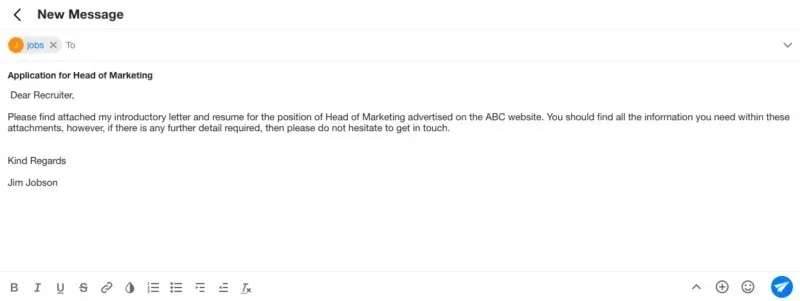
Professional Email Example for Your Team
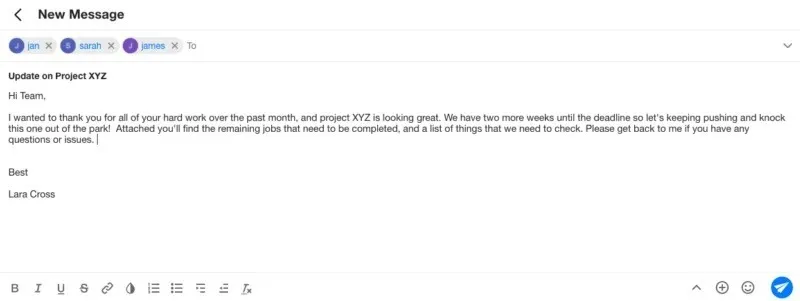
Professional Email Example in Response
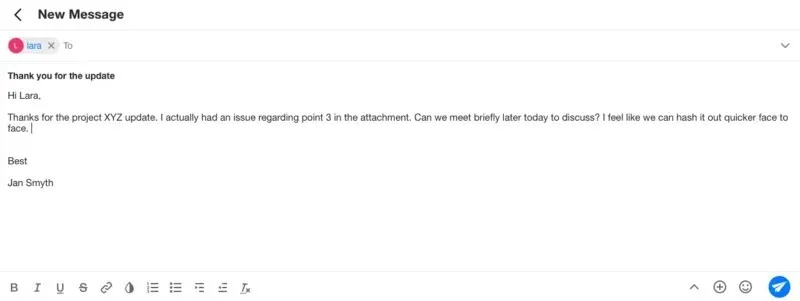
Professional Email Example to a Professor/Teacher
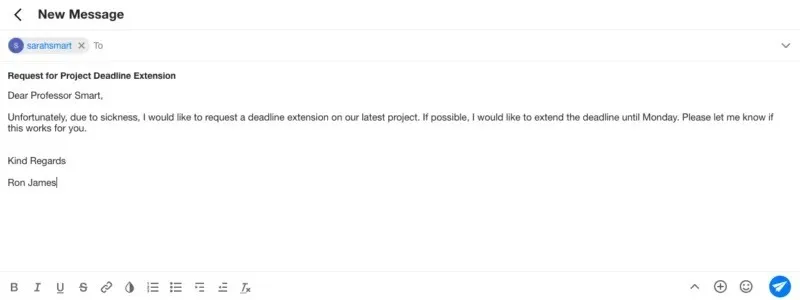
Professional Email Example for a Marketing Email
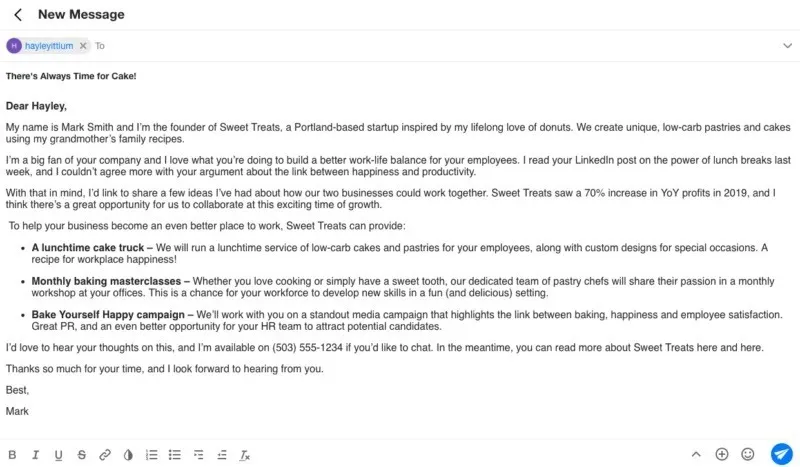
When it comes to writing the perfect email for any occasion, Spike’s got your back. Download Spike today and check out how our magical productivity-enhancing features can help you rock your communications and boost productivity every day.
Professional Email FAQ's
Once you have the basics down, you can easily write a professional email for any purpose. Make sure you are polite and friendly while also ensuring you lay out all of the information you want to convey clearly. Additionally, make sure you have an informative subject line and that you sign off in a formal way with your signature.
Professional email etiquette is useful in any business or educational setting, and you should be using professional email skills to write to colleagues, clients, customers, and peers.
While there’s no single font that is the best for a professional email, you should use something simple and legible so that your message is easy to read. Additionally, it’s worth noting that many email programs don’t support multiple fonts, so you should stick to a common font so that your email is displayed how it was written.
If you are writing a professional email to a group of people, then the same rules apply as if you are writing to a single person. However, it is important to understand the difference between CC and BCC so that you can ensure etiquette and privacy are maintained.
A professional email address should be concise and will usually be tied to your company or organization. It should also include your name so that people know who they are messaging and how to contact you. It is also a good idea to include your job title so that people know to who they are sending an email and can get in touch with you if necessary.
An email address ending in @gmail.com indicates that the user has a Google account, which most people use for their personal emails. It’s best to get an email account that uses your business domain name. This will make it clear that you’re a professional and help protect your email from becoming compromised. It’s also a good idea to use a Google Workspace account if you want to sign up for Google services like Google Drive or Google Docs, which are used by many businesses.
An email signature is a good way to include further information and sign off your email professionally. It should include your name, your company or organization name, possibly a logo, and further contact information such as alternative emails or phone numbers.
Gain Communication Clarity with Spike
You may also like
Quick and Easy Email Templates Designed for Humans
Learn about how to add a human touch to your email templates and keep your contacts in the loop even when your inbox is overflowing.
Read More10 Tips for Effective Email Writing
Writing effective emails is an essential skill in any modern workplace, and like other skills, with practice (and some valuable tips), it can be mastered by anyone. Here’s where to start…
Email Automation – What it Is and How to Use It
Maximize your business’ online marketing strategies with email automation. Learn more about and when to use it.
Read More



